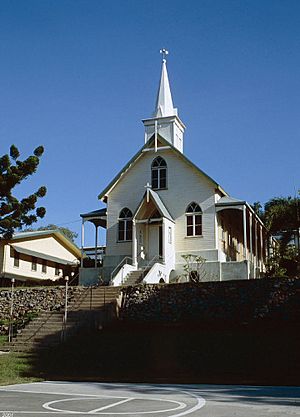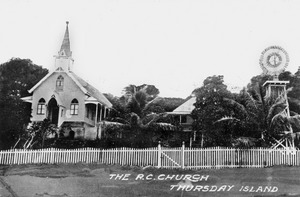Our Lady of the Sacred Heart Church, Thursday Island facts for kids
Quick facts for kids Our Lady of the Sacred Heart Church |
|
|---|---|

Our Lady of the Sacred Heart Church, 2001
|
|
| 10°35′01″S 142°12′55″E / 10.5836°S 142.2154°E | |
| Country | Australia |
| Denomination | Roman Catholic |
| History | |
| Status | Church |
| Architecture | |
| Style | Gothic Revival |
| Years built | c. 1885 – c. 1905 |
| Administration | |
| Parish | Thursday Island |
| Diocese | Cairns |
Our Lady of the Sacred Heart Church is a very old and important Catholic church on Thursday Island, Queensland, Australia. It's located at 120 Douglas Street. This church was built between around 1885 and 1905. It is listed on the Queensland Heritage Register, which means it's a special historical building.
Contents
History of the Church
Early Days on Thursday Island
French and Italian priests from the Missionaries of the Sacred Heart built Our Lady of the Sacred Heart Church. They arrived on Thursday Island in October 1884. They started the first Catholic mission in the Torres Strait area. A small church was built around 1885. Some people think this might be the oldest building still standing on Thursday Island. By about 1905, the church looked much like it does today.
Thursday Island became an important place because of the pearl-shelling and sea cucumber fishing industries. Many people from different countries came to work there. The island was also a key port for ships traveling to Asia and northern England.
Missionaries Arrive
The Mission of Our Lady of the Sacred Heart started in France in the 1860s. In 1881, Pope Leo XIII asked them to start a mission in New Guinea. The missionaries decided to set up a base on Thursday Island first. This would help them travel between their missions in Australia and New Guinea.
On October 24, 1884, the first three missionaries arrived on Thursday Island. They were Father Louis Andre Navarre, Father Ferdinand Hartzer, and Brother Giuseppe de Santis. Soon, more priests and brothers joined them. At first, Sunday Mass was held in a hotel. Many Filipino pearl fishers came to attend.
In January 1885, the priests bought land on Thursday Island. By February 1886, they had built a small church and a house. By December 1886, the mission had three buildings. These included a simple iron church, a small convent for four nuns, and a house for the priests. This house also helped sick priests from New Guinea recover.
Growing the Mission
From 1884 to 1889, the Thursday Island mission was a starting point for many Catholic missions. These missions were in British New Guinea and New Britain. The first Sisters of Our Lady of the Sacred Heart arrived in January 1886. A year later, they opened a small school on the convent's porch. A proper school building was built around 1900.
The Sisters also started Thursday Island's first hospital. This was before the government built its own hospital around 1910. In 1889, the missionaries also opened St Henry's Roman Catholic Asylum. This was a charity home and school for children of all backgrounds. It closed in 1942 but reopened briefly in 1948. Later, it became the Our Lady of the Sacred Heart School. A new school was built in 1973.
Changes and Art
In 1927, Father J Doyle became the Parish Priest on Thursday Island. He helped start a mission on Hammond Island in 1929. This mission served pearl divers and their families.
In 1935, a talented artist named David Sing painted murals inside Our Lady of the Sacred Heart Church. David Sing was born on Thursday Island in 1911. He painted amazing trompe l'oeil murals on the back wall of the sanctuary and on the front of the altar. Trompe l'oeil means "deceive the eye," making flat paintings look three-dimensional. David Sing became a lay missionary at 17. He studied art in Sydney, Paris, and Rome. His paintings were very popular and helped support his religious order.
In 1938, the Sacred Heart Mission in the Torres Strait became part of the Diocese of Darwin. In 1967, it moved to the Diocese of Cairns. Since 1968, the Sacred Heart school on Thursday Island has been run by the Sisters of Mercy from Cairns.
In 1983, the church's spire (the tall, pointed part of the roof) was replaced. The old one was made of flat iron, and the new one was a copy made of fibreglass. The roof was also repaired in 1992.
What the Church Looks Like
Our Lady of the Sacred Heart Church is a large timber building. It has a pointed roof covered with galvanised iron. The church stands on concrete foundations. It is easy to see from Douglas Street and from the water, making it a noticeable part of Thursday Island's view. It is near other Catholic buildings like the presbytery (priest's house), convent, and school.
The church is shaped like a rectangle. It has a small front porch and verandahs (covered walkways) on the sides. There is also a vestry at the back, which is a room where priests prepare for services. The building is raised off the ground on concrete supports.
The front of the church faces south-east. It has a fibreglass spire. The main front door and the windows next to it have Gothic arches, which are pointed at the top. The windows along the sides of the church also have this shape. All the windows have many small panes of glass. Some have bright red, blue, green, and yellow glass.
The church grounds have stone walls that create terraces. Concrete steps lead from the lower areas up to the church's front door.
Inside, the church is one large rectangular room. It is divided into the nave (where people sit) and the sanctuary (the area around the altar). The walls and ceiling are made of timber boards. At the back of the nave, above the entrance, is a choir loft. This is a raised area for the choir. It has a pretty cast-iron railing and nice timber work. A wooden confessional (a small booth for confessions) is also at the back.
The floors are made of timber. The sanctuary floor is about 60 centimetres higher than the nave floor. It has two steps leading up to it. The sanctuary has a beautiful carved timber altar. The entire back wall of the sanctuary has the amazing trompe l'oeil mural painted in 1935. There is also similar artwork on the front of the altar. A round window with painted glass is above the altar. Two doors in the back wall lead to the vestry.
Why the Church is Important
Our Lady of the Sacred Heart Church was added to the Queensland Heritage Register on December 7, 1998. It is important for several reasons:
- History of Queensland: The church shows how European missionaries started their work in the Torres Strait a long time ago. It also shows how Thursday Island grew into a key place in the late 1800s.
- Learning About History: This place can teach us about the early work of David Sing, an artist born on Thursday Island. He became famous around the world for his paintings.
- Special Church Features: The building is still mostly original. It is a good example of a late 19th-century timber church with Gothic designs and side verandahs. It still has many old parts, like the choir loft, pews, altar, and the 1930s painted murals.
- Beautiful Design: The outside of the church, with its verandahs, porch, and spire, is very pretty. It stands out as an important building on Thursday Island.
- Community Connection: The church is very important to the local community, especially the Islander people, for their cultural and spiritual beliefs.
- Important People and Groups: The church is strongly connected to the work of the Order of Our Lady of the Sacred Heart. This Catholic group was founded in France in the 1860s. It is also linked to their founder, Father Louis Andre Navarre, and to the early work of artist David Sing.


